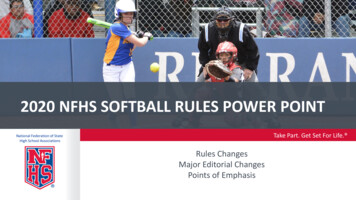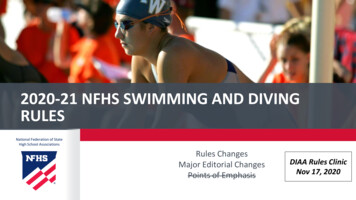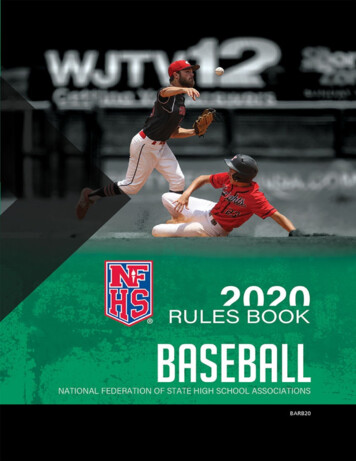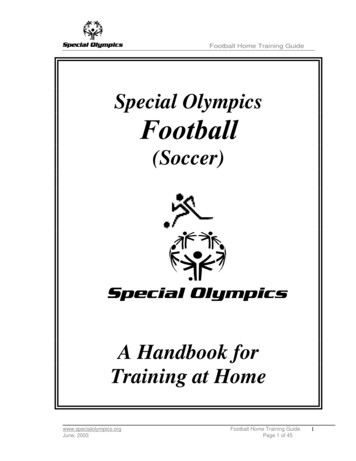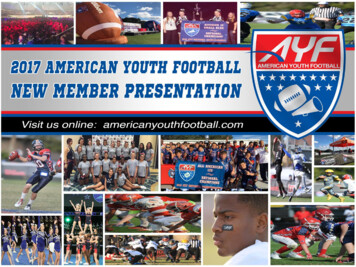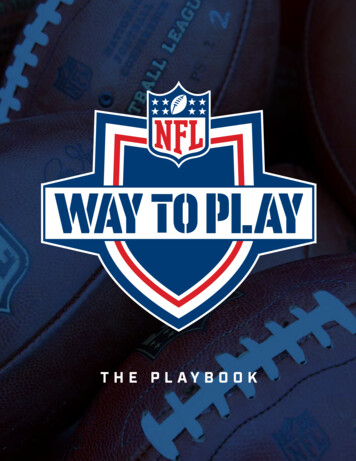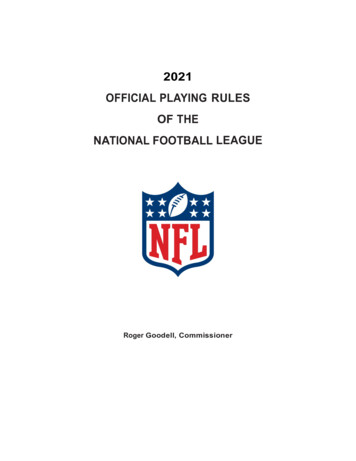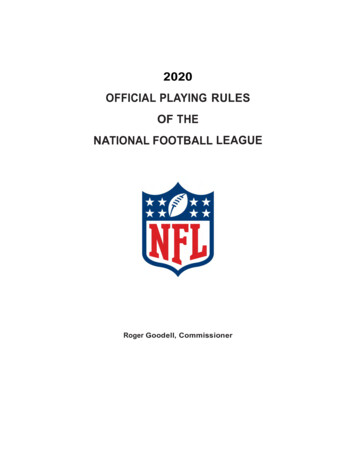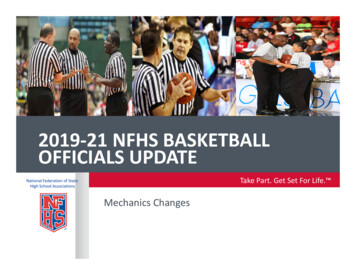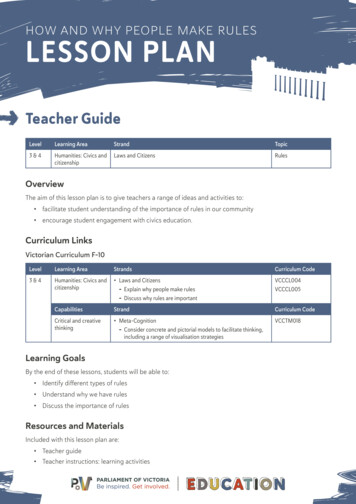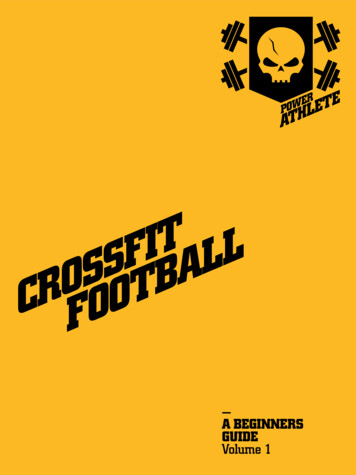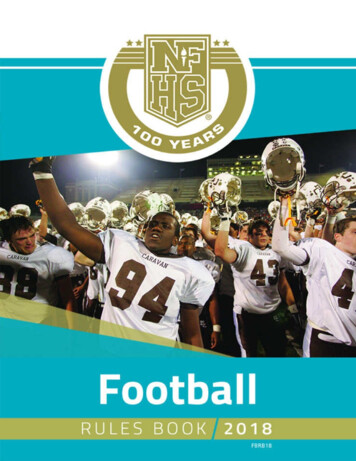
Transcription
2018 NFHS FOOTBALL RULESBOOKROBERT B. GARDNER, PublisherBob Colgate, EditorNFHS PublicationsTo maintain the sound traditions of this sport, encourage sportsmanshipand minimize the inherent risk of injury, the National Federation of StateHigh School Associations writes playing rules for varsity competitionamong student-athletes of high school age. High school coaches, officialsand administrators who have knowledge and experience regarding thisparticular sport and age group volunteer their time to serve on the rulescommittee. Member associations of the NFHS independently makedecisions regarding compliance with or modification of these playingrules for the student-athletes in their respective states.NFHS rules are used by education-based and non-education-basedorganizations serving children of varying skill levels who are of highschool age and younger. In order to make NFHS rules skill-level and agelevel appropriate, the rules may be modified by any organization thatchooses to use them. Except as may be specifically noted in this rulesbook, the NFHS makes no recommendation about the nature or extent ofthe modifications that may be appropriate for children who are younger orless skilled than high school varsity athletes.Every individual using these rules is responsible for prudent judgmentwith respect to each contest, athlete and facility, and each athlete isresponsible for exercising caution and good sportsmanship. These rulesshould be interpreted and applied so as to make reasonableaccommodations for athletes, coaches and officials with disabilities.
2018, By the National Federation of State High School Associations.Neither the whole nor any part of this publication may be copied orreproduced and/or translated without first obtaining express writtenpermission from the publisher.Republication of all or any portion of this publication on the Internetis expressly prohibited. Published by the NATIONALFEDERATION OF STATE HIGH SCHOOL ASSOCIATIONS, POBox 690, Indianapolis, Indiana 46206; Phone: 317-972-6900, Fax:317.822.5700, www.nfhs.org. Cover photo courtesy of Visual ImagePhotography, Illinois.
2018 Football Rules Changes1-5-4, 1-5-5, 3-5-10e (NEW), 3-6-2, 9-8-1h, 9-9 — Improperly equippedplayer shall be replaced for at least one down.2-32-16a — Defenseless player provisions for passer clarified.6-1-3b PENALTY, 6-1-4 PENALTY — Signal change for free kickinfractions.6-1-9b (NEW), 6-1-9b PENALTY (NEW), 10-4-2 EXCEPTION(NEW), 10-5-1j (NEW) — New penalty option adopted for fouls bykicking team.SIX-PLAYER FOOTBALL (RULE 3) — Length of time betweenperiods revised.
2018 Football Editorial ChangesField Diagrams, 1-3-7, Table 1-7 (9.), 3-4-2c, 3-5-2b, 3-5-5b, 3-6PENALTY, 5-1-2a, 7-2-5b EXCEPTION (1), Table 7-5-4, 7-5-5, 9-4PENALTY, 9-5-1h, 9-7-2 EXCEPTION, 9-8-1j, 10-4-7, Resolving TiedGames, Penalty Summary, NFHS Official Football Signals, Index.
2018 Football Points of Emphasis1. Proper Wearing and Use of Required Equipment2. Blindside Blocks and Defenseless Player3. Enforcement of Penalties for Personal Fouls and UnsportsmanlikeConduct Fouls4. Pace of Play and Timing Issues
2018 NFHS Football Rules CommitteeChair: Todd Tharp, IowaVice Chair: Richard McWhirter, TennesseeAlabama - Mark JonesAlaska - Brian HoskenArizona - Tyler CerimeliArkansas - Steve RobertsCalifornia - Steve CooverColorado - Tom RobinsonConnecticut - Leroy WilliamsDelaware - Tommie NeubauerDistrict of Columbia - Dwayne Marcus, Sr.Florida - Frank BeasleyGeorgia - Tommy WhittleHawaii - Georges GilbertIdaho - Ty JonesIllinois - Sam KnoxIndiana - Robert FaulkensIowa - Todd TharpKansas - Mark LentzKentucky - Julian TackettLouisiana - Keith AlexanderMaine - Ralph DamrenMaryland - Bill WitteMichigan - Nate HamptonMinnesota - Kevin MerkleMississippi - Robert HollowayMissouri - Greg StahlMontana - Brian MichelottiNebraska - Nate NeuhausNevada - Jim CavinNew Hampshire - Steve HallNew Jersey - Jack DuBoisNew Mexico - Dusty Young
New York - Gary VanDerzeeNorth Carolina - Mark DreibelbisNorth Dakota - Jeff RiskOhio - Beau RuggOklahoma - Mike WhaleyOregon - Brad GarrettPennsylvania - Paul SheehanRhode Island - John AbbateSouth Carolina - Bruce HulionSouth Dakota - John KrogstrandTennessee - Richard McWhirterUtah - Brenan JacksonVermont - Bob DavisVirginia - Tom DolanWashington - John MillerWest Virginia - Mike WebbWisconsin - Wade LabeckiWyoming - Trevor WilsonNFHS-CA - Scott ReedNFHS-OA - Jeff HilyerNFHS SMAC - Michael Koester, M.D. (Ex-Officio)
2018 NFHS Football Editorial Committee
Table of ContentsHelmet Warning InformationField DiagramsRule 1. The Game, Field, Players and EquipmentRule 2. Definitions of Playing TermsRule 3. Periods, Time Factors and SubstitutionsRule 4. Ball in Play, Dead Ball and Out of BoundsRule 5. Series of Downs, Number of Down and Team Possessions AfterPenaltyRule 6. Kicking the Ball and Fair CatchRule 7. Snapping, Handling and Passing the BallRule 8. Scoring Plays and TouchbacksRule 9. Conduct of Players and OthersRule 10. Enforcement of PenaltiesFootball FundamentalsResolving Tied GamesNine-, Eight-, and Six-Player Rules DifferencesOfficial Football SignalsPenalty Summary
2018 Points of EmphasisComments on the 2018 Rules ChangesAppendix A: Mission StatementAppendix B: Suggested Guidelines for the Management of Concussion inSportsAppendix C: Equipment GuidelinesAppendix D: Communicable Disease ProceduresAppendix E: Lightning and Thunder GuidelinesAppendix F: Coaches Code of EthicsAppendix G: Officials Code of Ethics
NFHS DisclaimersEach state high school association adopting these rules is the sole andexclusive source of binding rules interpretations for contests involving itsmember schools. Any person having questions about the interpretation ofNFHS rules should contact the rules interpreter designated by his or herstate high school association.The NFHS is the sole and exclusive source of model interpretations ofNFHS rules. State rules interpreters may contact the NFHS for modelrules interpretations. No other model rules interpretations should beconsidered.NOTE: Except as specifically stated within the rules of a given sport, anydimensions or other information in diagrams of courts, fields, pools, rinksand mats is suggestive only; it is not required by NFHS rules. Theconstruction and layout of all facilities used for high school competitionare subject to any applicable laws and building codes, and to the soundjudgment of the persons in charge of the facilities.DISCLAIMER – NFHS Position Statements and Guidelines: TheNFHS regularly distributes position statements and guidelines to promotepublic awareness of certain health and safety-related issues. Suchinformation is neither exhaustive nor necessarily applicable to allcircumstances or individuals, and is no substitute for consultation withappropriate health-care professionals. Statutes, codes or environmentalconditions may be relevant. NFHS position statements or guidelinesshould be considered in conjunction with other pertinent materials whentaking action or planning care. The NFHS reserves the right to rescind ormodify any such document at any time. Position Statements are located atthe end of this eBook.FACILITIES: Because facilities used for high school athletics come inmany shapes, sizes and conditions, on-site event management may onoccasion conclude that compliance with NFHS directives about eventconfiguration is not feasible. Under all circumstances, onsite event
management should utilize set-ups that minimize risk under theconditions with which they deal. If a given facility cannot be madereasonably hazard-free, the event should be relocated.New rules changes are denoted with highlights.
SHARED RESPONSIBILITY AND FOOTBALLHELMET WARNING STATEMENTAthletes who participate in the sport of football accept the risk of injuries.However, athletes also have the right to assume that those who areresponsible for the conduct of the sport, i.e., administrators, coaches andathletic trainers, have taken reasonable precautions to minimize the riskof significant injury. Refinements in the playing rules, the development ofrisk minimization guidelines and the establishment of equipmentstandards have helped to reduce significant injuries. However, to legislatesafety via the rules book and equipment standards is never a completeanswer. All who are involved with participation in the sport of footballshare in the responsibility of minimizing the sport’s inherent risks.The coach is responsible for pregame verification that in addition to otherrequired equipment, each player has a helmet which meet NationalOperating Committee on Standards for Athletic Equipment (NOCSAE)standards when manufactured and that each helmet has an exteriorwarning label. While important, the fact the athletes are wearing certifiedhelmets is only the first step. The athletes involved must be aware of allthe basic principles of head and neck injury prevention.Helmet Warning StatementSince 1985, the NOCSAE football helmet standard has required awarning label on the outside of the helmet to inform each player of theserisks and responsibilities. Each helmet shall have permanently affixed tothe exterior of the shell a clearly legible statement which can be easilyread without removal of any decal tape, other temporary material orpermanent part, which contains language that effectively communicatesto the purchaser and user the following information, using the same orsimilar language:
Field Diagrams11-player Football Field
Nine-player Football Field
NOTE: By state association adoption, the dimensions of the field may bealtered.
Eight- and Six-player Football Field
NOTE: By state association adoption, the dimensions of the field may bealtered.
Rule 1 The Game, Field, Players and Equipment
SECTION 1 THE GAMEART. 1 . . . It is the object of the game for one team to carry or pass theball across the opponent’s goal line or to kick the ball through theopponent’s goal by a place kick or drop kick. The game is won by theteam which accumulates the most points.ART. 2 . . . The game of football is played with an inflated ball by twoteams on a rectangular field 360 by 160 feet. While the ball is live, aninterval called a down is in progress and the team in possession attemptsto advance the ball by carrying, kicking or passing it. If a foul occurs, thepenalty loss, if not declined, is enforced during the interval betweendowns. The team in possession has a series of four downs numbered 1, 2,3 and 4 to advance the ball to the line to gain, which is usually 10 yards inadvance of the spot where the series begins. Points are scored bytouchdown, successful try, field goal or safety.ART. 3 . . . Each team shall begin the game with 11 players, but if it hasno substitutes to replace injured or disqualified players, it may continuewith fewer.ART. 4 . . . The game is administered by game officials whose title andduties are stated in the NFHS Football Game Officials Manual.NOTE: Each state association may determine the number of gameofficials to be used.ART. 5 . . . Prior to the game, the referee shall meet with the headcoach(es) and captain(s) and explain that everyone is expected to exhibitgood sportsmanship throughout the game.ART. 6 . . . The referee has authority to rule promptly, and in the spirit ofgood sportsmanship, on any situation not specifically covered in the rules.The referee’s decisions are final in all matters pertaining to the game.ART. 7 . . . The game officials shall assume authority for the contest,including penalizing unsportsmanlike acts, 30 minutes prior to the
scheduled game time - an earlier time if required by the state association or as soon thereafter as they are able to be present.ART. 8 . . . The game officials’ authority extends through the referee’sdeclaration of the end of the fourth period or overtime. The game officialsretain clerical authority over the game through the completion of anyreports, including those imposing disqualifications, that are responsive toactions occurring while the game officials had jurisdiction. StateAssociations may intercede in the event of unusual incidents that occurbefore, during or after the game officials’ jurisdiction has ended or in theevent that a game is terminated prior to the conclusion of regulation play.ART. 9 . . . The game officials shall have the authority to make decisionsfor infractions of the rules. The use of any replay or television monitoringequipment by the game officials in making any decision relating to thegame is prohibited.ART. 10 . . . The referee’s decision to forfeit a game is final.ART. 11 . . . Protests of NFHS rules are not recognized.
SECTION 2 THE FIELD AND MARKINGSART. 1 . . . The field shall be a rectangular area with dimensions, lines,zones, goals and markers as shown on the accompanying diagram. Thereshall be two sidelines running the length of the field along each side thatserve as boundary lines for play. It is recommended there be a slope of ¼inch per foot from the center of the field to each sideline on a naturalgrass field. There shall be two goal lines, running parallel to each otherand perpendicular to the sidelines. The field of play is the area within theboundary lines, and the goal lines. There shall be two endlines, runningparallel to each other, parallel to the goal lines that serve as a boundaryline for play.NOTE: The rise from each sideline to the center of a natural grass field is20 inches when the recommended slope is used.ART. 2 . . . Yard-line markers, constructed of soft, pliable materials, ifplaced on the ground, should be no closer than 5 yards to the sideline.ART. 3 . . . Lines and other markings:a. Lines shall be marked with a noncaustic, nontoxic materialdesigned for marking fields such as powdered gypsum, calciumcarbonate and liquid aerosol paint. It is recommended that these linesbe white. Neither lime, hydrated lime or other chemical derivativesof lime, nor caustic material of any kind may be used for markingfootball fields.b. Yard lines shall be marked with a continuous line every 5 yardsbeginning and ending 4 inches from each sideline.NOTES:1. Game administration may place on the field of play, 4 inches from eachsideline, yard-line extensions that should be 24 inches in length and 4inches in width.
2. If the field of play has a logo in the center or at any other part of thefield of play, that logo shall not obstruct the visibility of the requiredmarks every five yards. A solid or shadow-bordered 4-inch-wide line ispermissible. A shadow line is a line that designates the required 4-inchwidth by use of a border or outline lines, at least ¼-inch wide which shalllie within the 4-inch width. Shadow lines that are the natural color of thefield of play are permissible. The area within these lines need not be onecolor, but the continuous 4-inch-wide outline must be clearly visible tothe game officials.c. End lines and sidelines shall be continuous lines at least 4 incheswide. All other field dimension lines should be marked 4 inches inwidth.d. A 4-inch-wide restraining line shall be placed around the outsideof the field, at least 2 yards from the sidelines and end lines, as anextension of the line limiting the team box area, except in stadiumswhere the total playing enclosure does not permit the restrainingline. It is recommended that the restraining line be marked byplacing 12-inch-long lines, separated at 24-inch intervals.NOTE: Game administration may place 4-inch wide and 12-inch longbisecting marks along the restraining line at each 5-yard line between thegoal lines.e. A series of “hash marks” should be 24 inches in length and 4 inches in width and shall be located 53 feet, 4 inches from andparallel with each sideline dividing the field of play longitudinally inthirds. The lines shall be marked so that each 5-yard line bisects thehash mark.NOTES:1. Game administration may place on the field of play, with the inneredge of the extension in line with the outer edge of the hash mark, yardline extensions that should be 24 inches in length and 4 inches in width.2. It is permissible to use college or professional fields with hash marks
marked at the distance specified by their respective codes, and withadvertising and/or commercial markings placed on the field of play byhome management that meet the requirements of Rule 1-2-3l.f. 9-yard marks, 12 inches in length and 4 inches in width, shall belocated 9 yards from each sideline. The 9-yard marks shall bemarked so that at least each successive 10-yard line bisects the 9yard marks. These marks shall not be required if the field of play isvisibly numbered. If on-the-field numbers are used, the tops of thosenumbers shall be 9 yards from the sideline, should be 6 feet in heightand 4 feet in width and may include directional arrows next to theyard-line numbers indicating the direction toward the nearest goalline.g. Team boxes shall be marked on each side of the field outside thecoaches’ area between the 25-yard lines for use of coaches,substitutes, athletic trainers, etc., affiliated with the team. Thecoaches’ area is a minimum of a 2-yard belt between the front of theteam box and the sideline, and becomes a restricted area when theball is live.NOTES:1. It is permissible for both team boxes to be on the same side of the field,provided each team box is marked between respective 20- and 45-yardlines.2. It is recommended goal lines and the team box boundaries be markedin a color which contrasts with other field markings and the area betweenthe sidelines and the team box boundaries be solid white or marked withdiagonal lines.h. Decorative markings in the end zones shall be no closer than 2feet from the boundary and the goal lines.i. Measurements shall be from the inside edges of the boundarymarks, such marks being out of bounds.
j. Each goal-line mark shall be entirely in its end zone so the edgetoward the field of play and its vertical plane is the actual goal line.The goal line shall extend from sideline to sideline.k. A line, 4 inches wide and a minimum of 24 inches in length, shallbe centered in the field of play, three yards from each goal line.l. Advertising and/or commercial markings shall not obstruct theyard lines, hash marks or 9-yard marks (7-yard marks in nine-, eightand six-player competition).ART. 4 . . . A soft, flexible pylon, which is 4 inches square, 18 incheshigh, either orange, red or yellow in color, and does not create risk, shallbe placed at the inside corner of each of the intersections of the sidelineswith the goal lines and the end lines, as well as with each intersection ofthe hash marks extended and shall be placed either 3 feet beyond the endlines or on the end lines. When properly placed, the goal line pylon is outof bounds at the intersection of the sideline and the goal line extended.ART. 5 . . . The goal:a . The goal is the vertical plane midway between the sidelinesextending indefinitely above the inside of the uprights and the frontedge of the crossbar and in the same vertical plane as the inside edgeof the end line.b. The top of the crossbar shall be 10 feet above the ground,measured from the base of each upright to the top of the crossbar atthe intersection, or at each end of the crossbar perpendicular to theground when a single pedestal is used.c. The crossbar shall be 23 feet, 4 inches long.d. The uprights shall be 23 feet, 4 inches apart inside to inside andeach upright may not exceed 4 inches in width.NOTE: It is permissible to use college or professional fields with goalpost uprights set at the width specified by their respective codes.
e. The uprights shall extend a minimum of 10 feet above thecrossbar.f. The goal posts shall be padded with resilient, shock absorbingmaterial to a height of at least 6 feet above the ground.g. The horizontal crossbar and the uprights above it shall be freefrom any decorative material except paint which is recommended tobe either silver, white or yellow in color. One wind directionalstreamer may be attached to the top of each upright. Winddirectional streamers shall be 4 inches in width, 42 inches in lengthand either red, orange, or yellow in color.
SECTION 3 GAME EQUIPMENTThe NFHS does not perform scientific tests on any specific items ofequipment to determine if the equipment poses undue risks to studentathletes, coaches, officials or spectators. Such determinations are theresponsibility of equipment manufacturers. For additional information onEquipment Guidelines.ART. 1 . . . The ball shall meet the following specifications:a. A tan-colored cover consisting of either pebbled-grain, cowhide orapproved composition (leather or rubber) case without corrugationsother than those formed by the natural seam grooves and the lace onone of the grooves.b. One set of either eight or 12 evenly spaced laces. The length ofthe lace shall be confined to within 3¾ inches from each end of theball.c. A continuous 1-inch white or yellow stripe centered 3 to 3¼inches from each end of the ball free from decorations or logosadded during or after production. Stripes shall be located only on thetwo panels adjacent to and perpendicular to the seam upon which thelaces are stitched.
d. Conforms to the shape and dimensions as shown in the diagram.e. Weighs between 14 and 15 ounces.f. Inflated to a pressure of 12½ to 13½ psi (pounds per square inch)or 878.8 to 949.1 grams per square centimeter.g. The ball for 9th grade and above, as in Table 1-3-1, shall includethe NFHS Authenticating Mark. The mark can be displayed in eitherformat:A current list of NFHS authenticated products can be found on thewebsite, www.nfhs.org.h. Contain only the following permissible items:1. Ball manufacturer's name and/or logo;2. School name, logo and/or mascot;3. Conference name and/or logo;4. State association name and/or logos; and5. NFHS name and/or logos.NOTE: By state high school association adoption, the ball to be used ingames involving only players below the 9th grade may have dimensionsas found in the following table:Table 1-3-1BALL SPECIFICATIONS9th grade and above 8th grade and below
WeightLong circumferenceLong AxisShort circumferenceInflation pressure14 to 15 ounces27 3/4 to 28 1/2 inches10 7/8 to 11 7/16 inches20 3/4 to 21 1/4 inches12 1/2 to 13 1/2 psi12 to 14 ounces26 to 27 inches10 to 11 inches19 to 20 inches12 1/2 to 13 1/2 psiMETHOD OF MEASURING1. All measurements shall be made after the ball is inflated to 13 psi.2. The long circumference should be measured 90 degrees from lacearound the ends of the ball, over the groove but not in the groove.3. The long axis should be measured from end to end but not in the noseindentation.4. The short circumference should be measured around the ball, over thevalve, over the lace, but not over a cross lace.ART. 2 . . . Each team shall provide at least one legal ball to the referee atthe time the game officials assume authority for the contest. Only legalballs approved by the referee may be used during the contest.Each team may use any referee-approved ball of its choice to free kick orstart a new series of downs. If a touchdown occurs following a change ofpossession and the scoring team did not put the ball in play, any refereeapproved ball may be used for the try.NOTE: By state association adoption, a specific ball which meetsspecifications may be mandated for postseason or state playoffcompetition.ART. 3 . . . The referee shall decide whether the ball meets specifications.If the field is wet, the referee may order the ball changed between downs.ART. 4 . . . A kicking tee shall be made of pliable material whichelevates the lowest point of the ball no more than 2 inches above the
ground.ART. 5 . . . Either a yardage chain which joins two rods exactly 10 yardsapart or any other 10-yard indicator with a visible line-to-gain indicatorshall be used as the official line-to-gain equipment. This equipment and adown indicator shall be provided by game management.a. The line-to-gain indicator shall be used to fix the line to gain, andthe down indicator shall be used to mark the spot of the ball andindicate the number of the down in a series. The game officials shallcheck the line-to-gain indicator for accuracy prior to the start of thegame.b. The official line-to-gain and down indicators shall be operatedapproximately 2 yards outside the sideline opposite the press box,except in stadiums where the total playing enclosure does not permit.If there is no press box, the location will be specified by gamemanagement at the request of the head linesman. The line-to-gainindicator shall be removed from the sideline when the line to gain isthe goal line.c. Unofficial auxiliary line-to-gain and down indicators may be usedon the sideline opposite the official line-to-gain and down indicators,and shall be operated approximately 2 yards outside the sideline,except in stadiums where the total playing enclosure does not permit.d. All line-to-gain and down-indicator rods shall have flat lower endscovered by protective caps.NOTE: It is recommended that the members of the crew wear distinctivevests or jackets furnished by home or game management.ART. 6 . . . A timing device referred to as “the game clock” or “theclock” shall be provided by the game management. The operator(s) shallbe approved by the referee.ART. 7 . . . Other than replay or television monitoring equipment, gameofficials may use supplementary equipment to aid in game administration
as authorized by the state association.
SECTION 4 PLAYER DESIGNATIONSART. 1 . . . Each team shall designate a player as field captain and onlyhe may communicate with game officials. His first choice of any offereddecision is final, except as in 6-5-4. Decisions involving penalties shall bemade before any charged time-out is granted either team.ART. 2 . . . For convenience, a player is designated by his position onoffense during the snap. Figure 1-4-2 shows one of the offensiveformations and the recommended numbering of players according toposition.ART. 3 . . . Each player shall be numbered 1 through 99 inclusive. See 72-5.Figure 1-4-2Recommended Numbering of Offensive Team Players
SECTION 5 PLAYER EQUIPMENTThe NFHS does not perform scientific tests on any specific items ofequipment to determine if the equipment poses undue risks to studentathletes, coaches, officials or spectators. Such determinations are theresponsibility of equipment manufacturers. For additional information onEquipment Guidelines.NOTE: As mentioned in Section 5, under Player Equipment, NOCSAErefers to the National Operating Committee on Standards for AthleticEquipment and SFIA refers to the Sports and Fitness IndustryAssociation.ART. 1 . . . Mandatory equipment. Each player shall participate whilewearing the following pieces of properly fitted equipment, which shall beprofessionally manufactured and not altered to decrease protection:a. Helmet and Face Mask:1. A helmet and face mask which met the NOCSAE standard atthe time of manufacture. The face mask shall have a surfacecovered with resilient material designed to prevent chipping,burrs or abrasiveness and be properly secured to the helmet asdesigned by the manufacturer.2. The helmet shall be secured by a properly fastened chin strapwith at least four attachment points.NOTE: All players shall wear helmets that carry a warning labelregarding the risk of injury and a manufacturer's or reconditioner'scertification indicating satisfaction of NOCSAE standards. All suchreconditioned helmets shall show recertification to indicate satisfactionwith the NOCSAE standard. The coach's pregame verification to thereferee and another game official that all players are legally equipped andin compliance with the rules includes the exterior warning label.b. Jersey:
1. A jersey, unaltered from the manufacturer’s originaldesign/production, and which shall be long enough to reach thetop of the pants and shall be tucked in if longer. It mustcompletely cover the shoulder pads and all pads worn above thewaist on the torso.2. Players of the visiting team shall wear jerseys, unalteredfrom the manufacturer’s original design/production, that meetthe following criteria:The body of the jersey (inside the shoulders, inclusive of theyoke of the jersey or the shoulders, below the collar, and to thebottom of the jersey) shall be white and shall contain only thelisted allowable adornments and accessory patterns in a color(s)that contrasts to white:(a) as the jersey number(s) required in 1-5-1c or as theschool’s nickname, school logo, school name and/or playername within the body and/or on the shoulders,(b) either as a decorative stripe placed during productionthat follows the curve of the raglan sleeve or following theshoulder seam in traditional yoke construction, not toexceed 1 inch at any point within the body of the jersey; oras decorative stripe(s) added in the shoulder area afterproduction, not to exceed 1 inch per stripe and total size ofcombined stripes not to exceed 3.5 inches,(c) within the collar, a maximum of 1 inch in width, and/or(d) as a side seam (insert connecting the back of the jerseyto the front), a maximum of 4 inches in width but any nonwhite color may not appear within the body of the jersey(inside the shoulders, inclusive of the yoke of the jersey orthe shoulders, below the collar, and to the bottom of thejersey). The exception to (d) would be what is stated in (b)above.
(e) The visiting team is responsible for avoidance ofsimilarity of colors, but if there is doubt, the referee mayrequire players of the home team to change jerseys.NOTE: One American flag, not to exceed 2 inches by 3 inches, may beworn or occupy space on each item of uniform apparel. By stateassociation adoption, to allow for special occasions, commemorative ormemorial patches, not to exceed 4 square inches, may be worn on theuniform without compromising its integrity.3
2018 NFHS FOOTBALL RULES BOOK ROBERT B. GARDNER, Publisher Bob Colgate, Editor NFHS Publications To maintain the sound traditions of this sport, encourage sportsmanship and minimize the inherent risk of injury, the National Federation of State High School Associations writ
